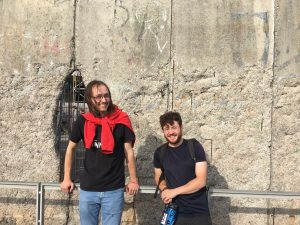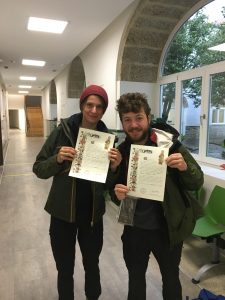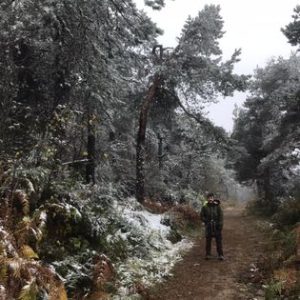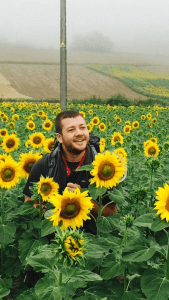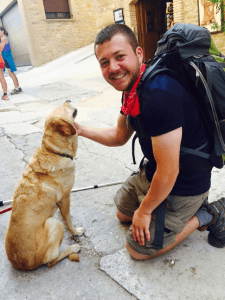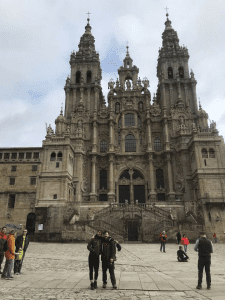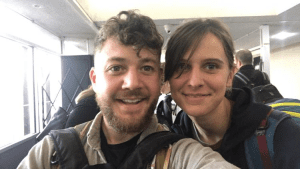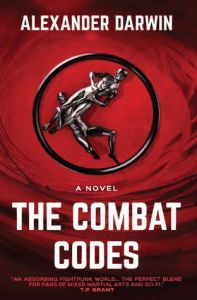Trekking, the Camino and How the BJJ Globetrotters Network Brought Me Home
Dust Mop Jiu Jitsu: The Expat Files: Chapter Five: Boston BJJ-Newton, Massachusetts
-On focusing on the journey instead of the destination and the importance of being a beginner
–
This is Chapter 5 of what I’m calling the Expat Files. If you want to know more about what this project is, you can read more about it in the first article here.
–
After Denmark, Rachel and I made our way to Germany, Spain and Portugal. By the end of our four month journey, we had explored mountains, tried surfing and obtained official documents absolving us of our sins (Neither of us are Catholic, but it can’t hurt). Each place was amazing but we had a special mission for Spain: the Camino de Santiago.
I’ve previously written about my love for trekking. Living out of a bag and only eating what you can carry gives you a simple daily structure . For the Camino:
| 7am: | Wake up, roll up your sleeping bag, lace up your boots, wolf down a pastry, slam back an espresso and start walking |
| 9am: | Stop for second breakfast |
| 9:30 am: | Keep walking |
| 1:00 pm: | Lunch |
| 1:30 pm: | Keep walking |
| 3 or 4 pm: | Find your hostel, claim a bunk bed, take shower and a nap |
| 5 pm: | Get dinner with some strangers and have the best conversation of your life |
| 8pm: | Bed |
It’s a hiking trail that’s like no other. You walk over the pyrenees, through the desert and then to the ocean. As a pilgrimage, these different parts of the trail have meanings. The first part, over the mountains, is good for the body. The second part, the Meseta, is devoid of scenery and it forces you to turn inward and examine your mind. The last, toward the cathedral of Santiago de Compostela, is for the soul.
Three years prior, I had started the Camino on my own. The whole thing takes six weeks, but in 2015, I only had three. I remember agonizing at the time about what I should do. Should I take a bus to the last bit? Perhaps I could skip the meseta. Maybe I could rent a bike.
I had fallen in with a group of hikers who gave me different advice. My assumption was that I would not be able to ever come back to Spain so I needed to get to Santiago now. I’ll never forget the conversation I had with this older French dude named Jerome.
Jerome: Ah so you will coupé (cut it) with a bus?
Me: I’m considering it
Jerome: But you will ruin it! Just walk to where you can and come back. You will see, it’s amazing! It will be just as you left it!
Me: But I’ll never be able to come back!
At the time, I was annoyed with him, but he was totally right. The best part of the Camino is starting it and looking forward to the journey. I remember meeting people who skipped the first few days so that they could make it to Santiago. I actually felt sorry for them. Like Jerome said, being a beginner is the best part. In contrast, the end of the Camino, in 2018, was totally sad. The hope that we would reach Santiago is what got me out of bed each morning, now we didn’t have that. Rachel and I actually labeled it Post Camino Depression. But the beginning, the bonding with other travelers, the arduous hikes, is what made it special.
After the trail, we flew to Boston from Barcelona. The cool thing is that we flew to Korea out of Los Angeles so since leaving the states, and then went to Europe and finally to Massachusetts. That meant that since leaving the USA for Ulsan in 2017 we had actually circumnavigated the globe.
It had been six weeks since I had trained any Jiu JitsuBy the time we arrived in the states. Luckily I knew exactly where I could go. Boston Brazilian Jiu-Jitsu Academy caught my eye years before going to Korea, but I was always too nervous to go in. But here I was, six months into training. I had already been brave enough to start the process and continue it in other people’s gyms. This would be my first foray into establishing myself as a BJJ practitioner in America. Interesting how for some, the globetrotters network brings them gyms all over the world. For me, it literally brought me home.
All that confidence crashed after I stepped onto the mats and saw a wall of people wearing black belts. At Ulsan Fight Gym in Korea, my instructor was a purple belt. In Thailand, I met black belt instructors but nobody else was at that level. This was the first time I saw black belts learning from black belts. To this day, Boston BJJ is the most black belt heavy gym I’ve been to.
The class was at 7 AM. I dragged myself out of bed to get there. In late November, a few guys were freezing at the door. The instructor, John, finally showed up late and herded us inside. Since none of the guys complained, I figured this must be normal. Nobody even noticed me enough to find out if I was a member. They just rushed on the mats and started a twenty-five minute game of King of the Guard.
If you haven’t played it, King of the Guard works like this:
- Everyone pairs up with one person being put in guard
- The person in guard has to pass
- If he makes it, he stays down and somebody new comes to him
- If he doesn’t he finds a new person
- The person who has guard needs to sweep or submit
- If he sweeps or submits, he stays where he is
- If he gets passed, he gets up and finds a new person
I got swept and submitted less than 30 seconds with each person. It wasn’t even close. These guys were toying with me like a cat with a ball of yarn.
One guy showed up late. He walked slowly, had wrinkles under his eyes and looked frail. He made the loudest old man noises as he stretched. Once he was on the mats, I walked over to him and he looked deep in my eyes. He spoke extremely slowly to me. “Listen. You are young. I am in my fifties. Okay? Be aware of our age differences and that I don’t heal as fast. OKAY?” Five seconds later I was in the tightest armbar I’ve ever felt.
I had never felt such a gap in skill. In Korea most people were beating me, but it didn’t feel like a shutout. This felt like being in a tornado. I got swept and submitted by everyone in less than a minute. One guy put his hand over my mouth and nose. I remember asking him if it was a legal move. “…no. Just something we like to use for newcomers.”
–
It’s not that black belts are inherently more athletic than everyone else. When you start Jiu Jitsu, you’re not used to moving around on the floor. The movements don’t have access to potential energy. Once your body gets used to that, you have a major advantage over somebody who isn’t. Think about what it’s like to run a race against somebody who doesn’t even know how to walk.
With more advanced people, the intimidation comes more from the sense that they always seem to know something you don’t. Now think about how those people are with each other, how much misdirection they learn to get what they want against somebody who sees their moves coming a mile away. It’s this learning curve that gives Jiu Jitsu its mythic status as the martial art for the little guy.
BJJ people love comparing jits to chess. “You get better by rolling with people who are better.” But these guys were honestly too far out of my league. I would get home feeling like I had never understood anything. They rarely even taught techniques unless the instructor felt like it. The schedule said they had a fundamentals class. I had not yet been to a gym that had separate classes for beginners. A prideful part of me didn’t want to think of myself as a beginner but I knew I had to give it a shot.
I actually ended up really liking the beginner’s class. There’s a split in the Jiu Jitsu world over how much time should be devoted to warm ups. Some feel it robs you of valuable time you could be focusing on Jiu Jitsu. But our instructor, Alex, led them in an interesting way. He would say “20 jumping jacks.” First he would count to ten then we would count in unison from 11-20. When you are new to a gym and a group of people, yet you find yourself moving in the same way as them, you inevitably feel a connection. That team feeling is what was missing from the class with all the Black Belts. Those guys weren’t trying to be exclusive, but the reality is they had all probably known each other for at least 10 years. Just like on the Camino, it’s easier to connect with people who are on the same leg of the journey as you.
Alex also explained some of the basic moves in a way that made me realize I had never understood them back in Ulsan. Alex’s class structure helped me feel like I did in Ulsan, that I was learning something new each day. (He’s also a good writer. Check out this article he wrote about Anthony Bourdain and BJJ or his sci-fi series on MMA. He writes about a dystopian world where wars are fought through MMA matches. The practices he describes in the book actually describe the kinds of methods he used at Boston BJJ).
I spent every day for almost a month at either the advanced or fundamentals class. And I I learned a lot. I like to think I was getting better, but I was more likely learning how to identify what I had been previously doing wrong. Here again, I found it interesting to be around such advanced folks. The advice I got from black belts was great, but the advice I got from blue and purple belts was honestly more helpful. Those were the folks that were most recently in my shoes.
Boston BJJ ended up becoming a second gym to me. I would soon move to Burlington, Vermont. My coach there had gotten his black belt from the Boston BJJ head coach, Roberto Maia, which meant I didn’t have to pay for drop ins. I would train there whenever I was visiting my parents or working in the area. I always looked forward to it as well. I still got crushed by the black belts each time, but I started learning from them as well.
Unfortunately, I think they took a hit during the pandemic. I’m not sure the full story, but all I know is that they don’t exist at that location anymore. I hope they get back on their feet soon and I can see those folks again. Since they closed, I’ve had to look for other gyms to train when I visit my folks. At a few places, I’ve seen some of the Boston BJJ diaspora. I always approach them and commiserate about how much we miss the academy.
The folks I walked with on the Camino DeSantiago will always have a special place in my heart. But similarly, the black belts who crushed me, the blue belts who mentored me and the white belts who grew with me will forever be a part of my BJJ journey.
The Dust Mop Takeaway:
Part of the reason for me writing this blog is to reflect on what it feels like to be a white belt after so much time. When I started BJJ, I remember hoping that I would make it to blue belt before I got to the states. But there’s something comforting about being a white belt. Nobody expects anything from you so it’s a win-win scenario. If you do poorly, nobody looks disappointed, and if you do well, everyone seems impressed (or annoyed depending on who you roll with). It’s honestly something that I think I will miss if I get promoted, that feeling like I’ve got nothing to lose.
At Boston BJJ, I learned to love being a beginner. I got the mindset that there’s always more to learn. Just like being on the camino, there’s always more trail to cover. It’s what inspires you to wake up at 7am, lace up your boots and get walking right away. For jits, it’s what inspires me to get to training five days a week.
–
My goal is to visit 100 gyms! If you ever want me to visit yours and write about what it’s like to learn from you, feel free to reach out at Du*************@***il.com.
If you want to read my articles as soon as they’re published, you can follow me here.


